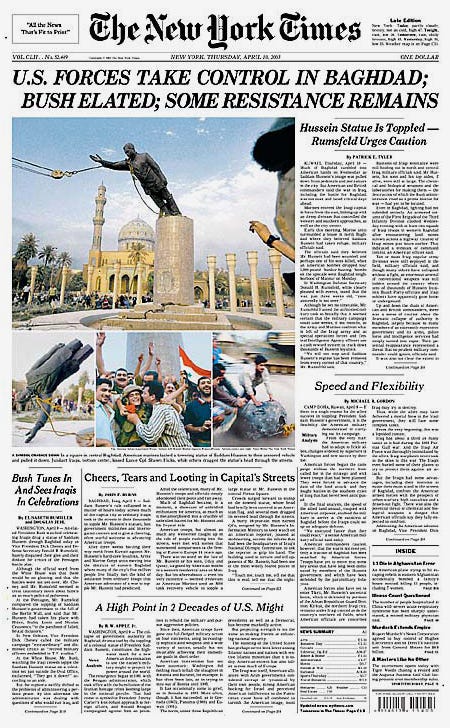This is the final installment in a three-part series.
After Marines pulled down the statue of Saddam Hussein in Baghdad on April 9, 2003, the crowd surged forward, assaulting the statue with hammers and shoes. Among them was Iraqi photographer Karim Sahib, who documented the chaotic, frenzied, scene for Agence France-Presse.
“I laughed when I saw the pictures I took. Just four days before I'd taken photos of the same people kissing the hand of Saddam's statue,” Sahib told The National. “How can nations change their opinion and mood in just days?”
Sahib’s photos were widely published, second only to Goran Tomasevic and Jerome Delay’s now-iconic images of the toppling.
Other photographers were in the mix, including the Delay, whose image emphasizes the shoes pelting the statue — a sign of disrespect in Arab culture. The Washington Post published this photo with a followup on the flag that famously covered the statue’s face.
Photographers Albert Facelly, Gilles Bassignac, and Jerome Sessini were in the mix as well. You can see in Sessini’s photo the damage inflicted by the man in the striped shirt (dominant in Sahib’s image above).
Soon afterwards, the statue was decapitated and dragged through the streets. The New York Times published Tyler Hicks’ photo of a group of men parading the severed head (bottom right).
Here’s the uncropped version of Hicks’ image. The rope that the Marines gave to the crowd to topple the statue was repurposed into a leash of sorts.
The Los Angeles Times’ Carolyn Cole captured a similar scene.
Cole also captured this jubilant scene after the toppling. While it feels a little hammy, I love all the elements — VE-Day vibes. The Times published a cropped version underneath Tomasevic’s photo of the toppling.
Alexandra Boulat also photographed the Saddam’s severed head, as it was ridden down the street by an Iraqi man smoking a cigarette. The photograph was published with her story in National Geographic’s September 2003 issue.
TIME published a photo by James Nachtwey of the head being carted off after things calmed down. The family in the car is a nice detail.
“I was born and brought up in Iraq and was taught Americans are the enemy. It was the first time to see them closely,” Iraqi photographer Karim Sahib recalled to The National.
“The soldiers were suspicious of me because I wasn’t friendly. They pulled out their guns, took my cameras and knocked me to the ground.”
Weeks later, Sahib photographed the horrific killing of four US contractors in Falllujah. “Our life became a nightmare. With the US troops, insurgents and militias, Baghdad became a front line.”
















